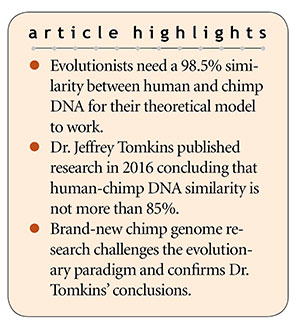 The more DNA sequencing technologies improve, the worse it gets for the evolutionary paradigm. Such is the case with the newest version of the chimpanzee genome.
The more DNA sequencing technologies improve, the worse it gets for the evolutionary paradigm. Such is the case with the newest version of the chimpanzee genome.
The more DNA sequencing technologies improve, the worse it gets for the evolutionary paradigm. ![]()
Since evolutionists speculate that humans and chimps shared a common ancestor about three to six million years ago, their theory requires a human-chimp DNA similarity of 98 to 99%. The first time they constructed a chimp genome and compared it to humans, they claimed 98.5% DNA similarity based on cherry-picked regions that were highly similar to human. However, an extensive DNA comparison study I published in 2016 revealed two major flaws in their construction of the chimp genome.1
First, many chimp DNA data sets were likely contaminated with human DNA, especially those produced in the first half of the chimpanzee genome project from 2002 to 2005. Second, the chimpanzee genome was deliberately constructed to be more human-like than it really is.2 Scientists assembled the small snippets of chimp DNA onto the human genome, using it as a scaffold or reference. It’s much like putting together a jigsaw puzzle by looking at the picture on the box as a guide. Since many chimpanzee data sets likely suffered from human DNA contamination, the level of humanness was amplified. I studied the 2005–2010 data sets that showed less human DNA data contamination and found they were only 85% similar to human at best.1
Just this year, scientists published a new version of the chimpanzee genome.3 This new version incorporated an advanced type of DNA sequencing technology that produces much longer snippets of DNA sequence than earlier technologies. It also involved better protocols that greatly reduce human DNA contamination. And most importantly, the authors report that the DNA sequences have been assembled without using the human genome as a scaffold.
They also acknowledged the flawed nature of previous versions of the chimp genome:
The higher-quality human genome assemblies have often been used to guide the final stages of nonhuman genome projects, including the order and orientation of sequence contigs and, perhaps more importantly, the annotation of genes. This bias has effectively “humanized” other ape genome assemblies.3
This confirms what many creationists have been pointing out for years.
Curiously, the authors of the new chimp genome paper said very little about the overall DNA similarity between humans and chimpanzees. However, the University of London’s specialist in evolutionary genomics, Dr. Richard Buggs, evaluated the results of an analysis that compared this new chimp version to the human genome and discovered some shocking anti-evolutionary findings.
Dr. Buggs reported on his website that “the percentage of nucleotides in the human genome that had one-to-one exact matches in the chimpanzee genome was 84.38%” and “4.06% had no alignment to the chimp assembly.” 4 Assuming the chimpanzee and human genomes are about the same size, this translates to an overall similarity of only about 80%! This outcome is way outside the nearly identical level of 98 to 99% similarity required for human evolution to seem plausible.
We did not descend from ape-like ancestors—we were created in God’s image to be in special relationship with Him. ![]()
Not only do these results refute the evolutionary story and confirm my previous research, but they also support human uniqueness as recorded in the book of Genesis.5 We did not descend from ape-like ancestors—we were created in God’s image to be in special relationship with Him, just as the Bible says.
References
- Tomkins, J. 2016. Analysis of 101 Chimpanzee Trace Read Data Sets: Assessment of Their Overall Similarity to Human and Possible Contamination With Human DNA. Answers Research Journal. 9: 294-298.
- Tomkins, J. 2011. How Genomes are Sequenced and Why It Matters: Implications for Studies in Comparative Genomics of Humans and Chimpanzees. Answers Research Journal. 4: 81-88.
- Kronenberg, Z. N. et al. 2018. High-resolution comparative analysis of great ape genomes. Science. 360 (6393).
- Buggs, R. How similar are human and chimpanzee genomes? Posted on richardbuggs.com July 14, 2018, accessed August 9, 2018.
- Genesis 1:27.
* Dr. Tomkins is Director of Life Sciences at the Institute for Creation Research and earned his Ph.D. in genetics from Clemson University.







